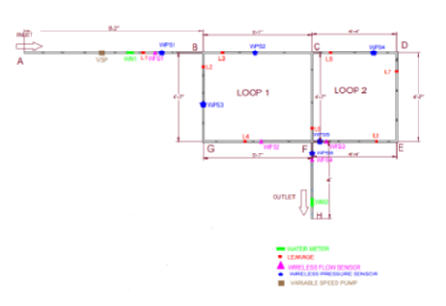


Indian Journal of Science and Technology
Year: 2022, Volume: 15, Issue: 23, Pages: 1133-1142
Original Article
Dipesh Dalal1*, Rupesh Vasani2
1Civil Engineering Department, Government Polytechnic for Girls, Gujarat Technological University, Ahmedabad, 380015, Gujarat, India
2Civil Engineering Department, Sal Education Campus, Gujarat Technological University, Ahmedabad, 380060, India
*Corresponding Author
Email: [email protected]
Received Date:01 January 2022, Accepted Date:29 April 2022, Published Date:24 June 2022
Objective: To pinpoint the leakage location using a machine learning algorithm on a real-time basis. Method: A laboratory experimental model was developed using wireless sensors for real-time data collection and monitoring the changes in the pressure and flow in presence of leakage under a different scenario. Modification in laboratory model was made considering Loop network of distribution pipes as compared to the simple experimental model. The model has been validated in EPANET software. The machine learning algorithm, along with the K-fold approach has been used to locate leakage and it was compared with other algorithms like Support Vector Machine (SVM), logistic regression, multilayer perceptron, Recurrent Neural Network-Long Short-Term Memory (RNN-LSTM), Principal Component Analysis (PCA), Artificial Neural Network (ANN), Random Forest, Gradient Boosting Tree (GBT) Classification, and Convolutional Neural Network (CNN). Findings: In this research, a system was developed based on real-time data received by Wireless Sensor Network (WSN) was demonstrated and it is able to find even a small leak by monitoring pressure and flow. The K-fold approach in machine learning algorithm has been used to locate the leakage in different variations made in the experimental model in terms of pressure, leak size, cross-section of pipe, and profile level of the pipe network. A comparison was also presented with other machine learning algorithms of recent research in terms of accuracy, size of the opening for the leak, type of experimental model used, and variables considered to locate the leakage. Novelty: It is the first research kind of work that shows the average accuracy of 78% to locate leakage based on the real-time experimental data in a loop network using the K-Fold approach.
Keywords: Leakage; Leakage Detection; Kfold approach; Pressure Measurements; Water Distribution Network; Wireless sensor
© 2022 Dalal & Vasani. This is an open-access article distributed under the terms of the Creative Commons Attribution License, which permits unrestricted use, distribution, and reproduction in any medium, provided the original author and source are credited.
Published By Indian Society for Education and Environment (iSee)
Subscribe now for latest articles and news.